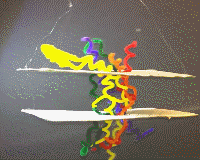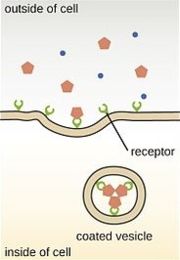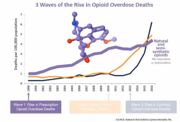Tutorial:The opioid receptor, a molecular switch
From Proteopedia
(→Tolerance and Abuse) |
|||
| Line 25: | Line 25: | ||
== Tolerance and Abuse== | == Tolerance and Abuse== | ||
[[Image:OpioidWaves.JPG|thumb|Structure of oxycodone with a background of the three waves of the Opioid Crisis: 1) Prescription Pain Medication (in gray) 2) Heroin (in orange) 3) Non-Prescribed (Black Market) Fentanyl (in navy)]] | [[Image:OpioidWaves.JPG|thumb|Structure of oxycodone with a background of the three waves of the Opioid Crisis: 1) Prescription Pain Medication (in gray) 2) Heroin (in orange) 3) Non-Prescribed (Black Market) Fentanyl (in navy)]] | ||
| - | When | + | When opioids are taken on a regular basis, the body adapts and shows less of a reaction. This is called [https://en.wikipedia.org/wiki/Drug_tolerance tolerance]. Once someone is tolerant to opioids, a higher dose is necessary to give the same pain relief. Tolerance also lowers the dopamine-releasing effects brought about by the presence of opioids in the body. The interaction between opioid receptor and arrestin, discussed in the previous section, is thought to play a role in tolerance. The adaptations in the body also are responsible for [https://en.wikipedia.org/wiki/Drug_withdrawal withdrawal] when not taking opioids for a while, inflicting crippling side-effects and cravings for the next drug dose. Going through multiple cycles of drug intake, withdrawal and craving can lead to a harmful behavior of seeking drugs even though the patient is aware of the dangers of overdose and the toll addiction has on an individual and their community. |
| - | + | This fictional account [https://vimeo.com/377826595 (video <span class="fas fa-video" style="color:#338fff"></span>)] tells a story of how initial exposure through prescribed medication leads to medication abuse and to switching to the even more addictive drug heroin. While some prescription medications include abuse-deterrent features, these have not prevented prescription drug abuse.[https://www.youtube.com/watch?v=n-azUelCgJg (video <span class="fas fa-video" style="color:#338fff"></span>)] . | |
==Overdose and Treatment== | ==Overdose and Treatment== | ||
Revision as of 00:15, 23 December 2019
The opioid receptor, a protein on the surface of nerve cells, binds to opioids such as morphine, oxicodone, heroin, and fentanyl. Repeated intake of opioids changes the response to these molecules, and can lead to addiction.
Contents |
About this page
This article explains, at a level appropriate to high school students or beginning college students, how the opioid receptor is switched on and off, and what happens inside the brain as a consequence. Five student-made videos accompany this article, and are referenced below. Other pages related to this topic, typically using more technical terms and assuming some prior knowledge in biochemistry, are:
Relevance
When we want to turn on the lights in a dark room, we don't have to climb up a ladder to screw in a light bulb. All we have to do is flip a switch. A biological cell has switches, too, called receptors. Most are on the cell surface with a part sticking out, ready to bind to a signaling molecule. Another part of the receptor reaches into the inside of the cell, transmitting the signal. The opioid receptor can be switched on to relieve pain, for example during surgery. Tragically, it is very easy to become physically dependent on the signaling molecules. The ongoing opioid crisis in the USA shows how addictive opioids are (e.g. morphine, oxicodone, heroin, and fentanyl), with overdose deaths decreasing average life expectancy across the US population significantly.
Natural Function
Opioid receptors are proteins found in neurons, the cells that allow us to think, to observe our surroundings with our senses and to move our muscles. Like all cells, neurons have a water-insoluble structure called membrane (or lipid bilayer) surrounding them, keeping molecules from moving into and out of the cell. Opioid receptors are integrated into this membrane with parts reaching out of the cell and parts reaching into the cell, allowing it to act like a switch that is turned on from the outside and affects the inside of the cell.
The human body has different types of opioid receptors called mu, kappa and delta; the mu receptor in particular is responsible for the addictive nature of morphine and other similar opioids involved in the 2010s opioid crisis. A conceptual model of the opioid receptor integrated into the membrane is shown at the top of the page. It shows that the protein is made of a single chain that passes across the membrane multiple times (this structure is shared with a larger group of so-called 7 pass transmembrane receptors)
These opioid receptors interact with opioids via a process known as ligand binding[1]. When an opioid molecule binds to its receptor, the shape of the receptor changes (a so-called conformational change[2] occurs). This change in the receptor causes it to release a GTP-binding protein (otherwise known as a G protein), which signals the inside of the cell to behave differently, for example not to cause the sensation of pain. Also, by signalling to other neurons via dopamine binding to the dopamine receptor, large doses of opioids can result in a feeling of pleasure.
The part of the receptor that interacts with the G proteins can also bind to another protein in the cell called arrestin. Arrestin, as its name suggest, stops a given receptor from always being on. When arrestin is bound, the receptor and a bit of the membrane it is integrated in form a tiny cell-like structure called a vesicle with the opioid binding site pointing inside (see figure at right). Due to increased acidity in the vesicle, the opioid receptor releases the bound opioid. Then, one of two events may occur; either the receptor is delivered back to the cell membrane, or it is broken down into its building blocks.
To see the receptor in action, you can watch a 4:35 min. video (video ) that connects the activity of an individual with the switching of the receptor in the cell
Tolerance and Abuse
When opioids are taken on a regular basis, the body adapts and shows less of a reaction. This is called tolerance. Once someone is tolerant to opioids, a higher dose is necessary to give the same pain relief. Tolerance also lowers the dopamine-releasing effects brought about by the presence of opioids in the body. The interaction between opioid receptor and arrestin, discussed in the previous section, is thought to play a role in tolerance. The adaptations in the body also are responsible for withdrawal when not taking opioids for a while, inflicting crippling side-effects and cravings for the next drug dose. Going through multiple cycles of drug intake, withdrawal and craving can lead to a harmful behavior of seeking drugs even though the patient is aware of the dangers of overdose and the toll addiction has on an individual and their community.
This fictional account (video ) tells a story of how initial exposure through prescribed medication leads to medication abuse and to switching to the even more addictive drug heroin. While some prescription medications include abuse-deterrent features, these have not prevented prescription drug abuse.(video ) .
Overdose and Treatment
When untreated, opioid overdose kills people because they stop breathing. The drug naloxone[3] can prevent overdose deaths when administered in time. (video ).
The continual presence of opioids in the body can have with it other effects. Within pregnant mothers, it may result in what is known as Neonatal Abstinence Syndrome (NAS) (video ), in which the fetus develops withdrawal symptoms after birth. This is due to the drugs passing through the placenta into the newborn's body prior to birth. Essentially, the infant develops opioid-dependence before even being born, which, in turn, inflicts a myriad of health complications, some of which are possibly fatal. However, there are multiple treatment options that are effective if medical support is available and the condition is diagnosed in time.
Structural highlights
| |||||||||||
Further reading
- NOVA: Addiction: A teaching guide answering frequently asked questions about opioid abuse and treatment.
- Review article on prescription opioid use and abuse by Nora Volkow and Thomas McLellan
- Membrane receptor and G-proteins: Chapter in the Berg/Tymoczko/Stryer Biochemistry textbook on membrane receptors and events mediated by G-proteins inside the cell.
- Lesson plan for a discussion based on five student-made videos



